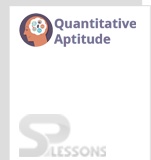 Introduction
Introduction
What is Quantitative Aptitude test?
Quantitative Aptitude is one of the prominent competitive aptitude subjects which evaluates numerical ability and problem solving skills of candidates. This test forms the major part of a number of important entrance and recruitment exams for different fields. The Quantitative Aptitude section primarily has questions related to the Simplification, Numbering Series, and Compound Interest, etc.
A candidate with quantitative aptitude knowledge will be in a better position to analyse and make sense of the given data. Quantitative Aptitude knowledge is an important measure for a prospective business executive's abilities.
The article TS CAB Recruitment Quantitative Aptitude Quiz 1 provides Quantitative Aptitude questions with answers useful to the candidates preparing for Competitive exams, Entrance exams, Interviews etc. The article TS CAB Recruitment Quantitative Aptitude Quiz 1 will assist the students to know the expected questions from Quantitative Aptitude.
 Quiz
Quiz
1. Two trains are moving in the same direction at 72 kmph and 36 kmph. The faster train crosses a man in the slower train in 27 seconds. Find the length of the faster train?
- A. 270 m
B. 250 m
C. 280 m
D. 220 m
- A. 25
B. 125
C. 24[latex]^ {1/5}[/latex]
D. 25[latex]^ {3/5}[/latex]
E. 5
- A. 40 sec
B. 47 sec
C. 33 sec
D. None of these
- A. 0
B. 1
C. 5
D. 60
- A. 4000
B. 5000
C. 6000
D. 7000
1. A sum of Rs. 125000 amounts to Rs. 15500 in 4 years at the rate of simple interest. What is the rate of interest?
- A. 3%
B. 4%
C. 5%
D. 6%
- A. 6
B. 9
C. 15
D. 18
- A. 50
B. 60
C. 70
D. 80
- A. Rs. 2736
B. Rs. 3800
C. Rs. 4788
D. Rs. 6840
- A. Rs.125
B. Rs.115
C. Rs.110
D. Rs.140
1. A drink vendor has 80 liters of Maaza, 144 liters of Pepsi and 368 liters of Sprite. He wants to pack them in cans, so that each can contains the same number of liters of a drink, and doesn't want to mix any two drinks in a can. What is the least number of cans required?
- A. 35
B. 37
C. 42
D. 30
- A. Rs.18000
B. Rs.17000
C. Rs.18500
D. Rs.17500
E. None of these.
- A. 37
B. 38
C. 39
D. 40
- A. 1 day
B. 2 days
C. 3 days
D. 4 days
- A. Rs. 196.58
B. Rs. 208.33
C. Rs. 210
D. Rs. 215.67





